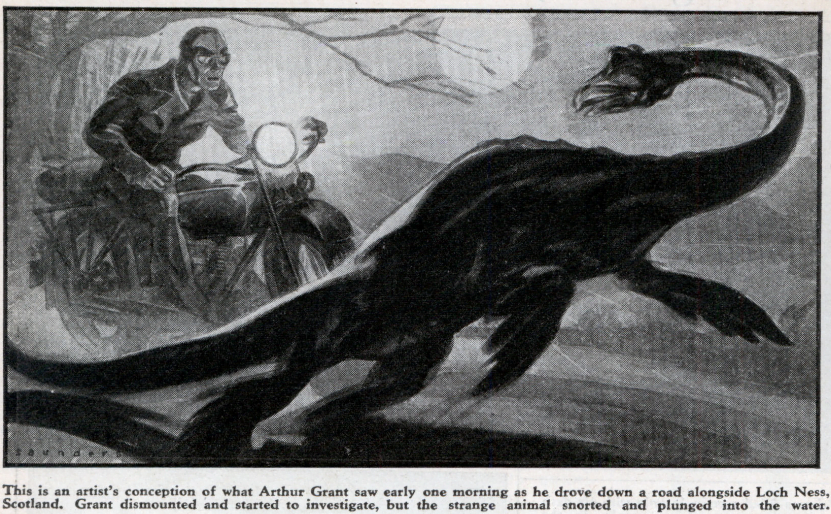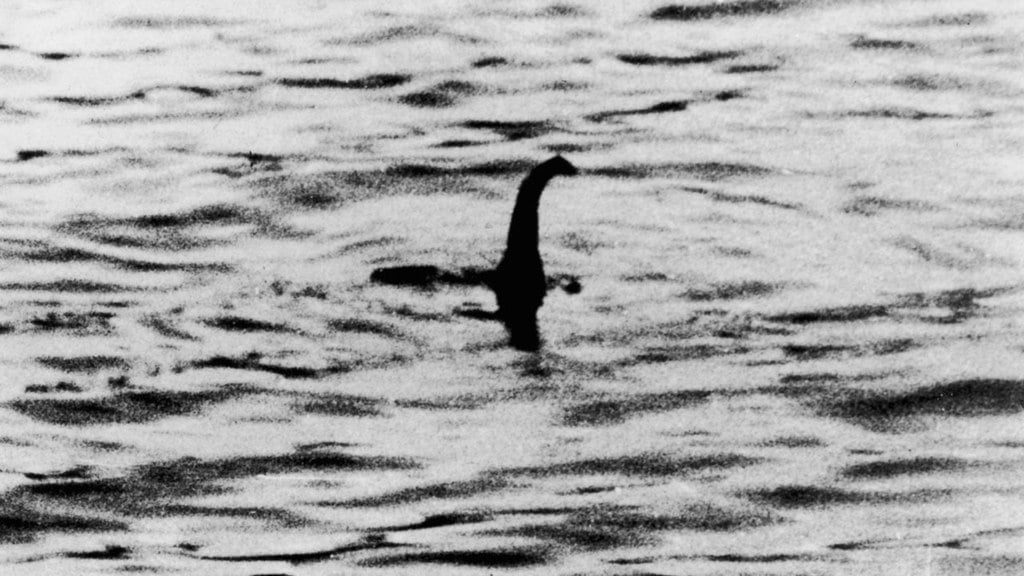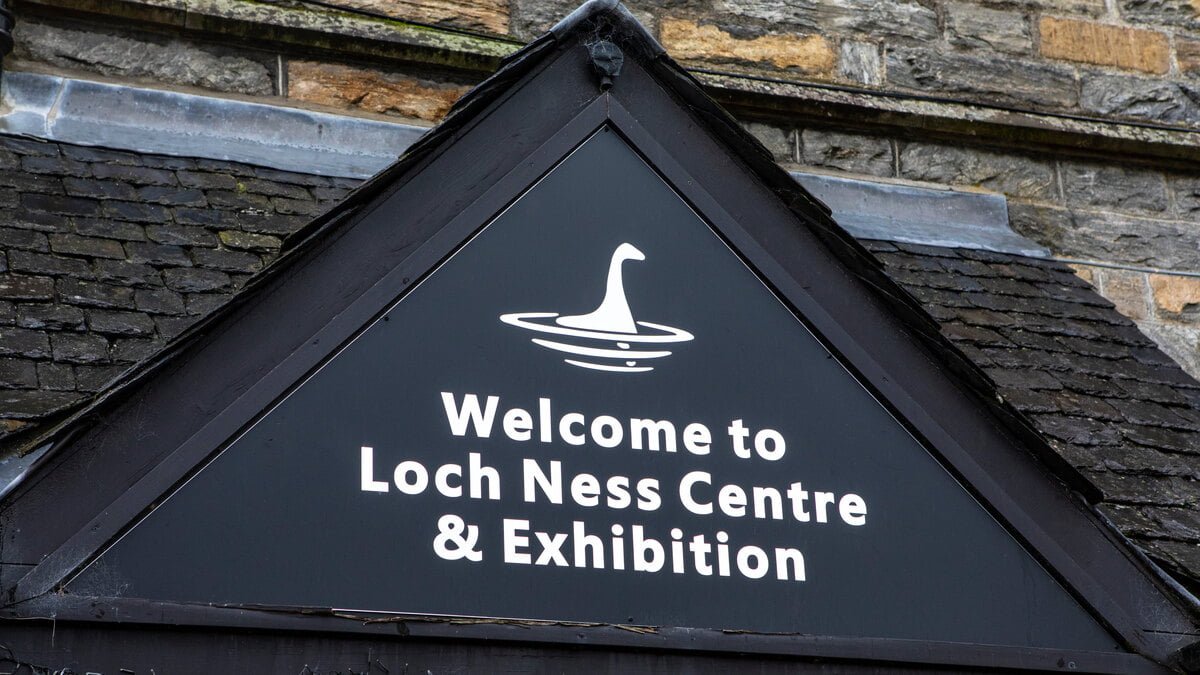The Loch Ness Monster, affectionately known as Nessie, has intrigued millions worldwide. Nestled in the Scottish Highlands, Loch Ness is purportedly the home of this elusive creature.
Is the Loch Ness Monster a dinosaur? Nessie is often thought to be a surviving plesiosaur. However, this is unlikely, as its reported neck posture, habitat preferences, and infrequent surface appearances are inconsistent with what paleontologists know about plesiosaurs.
We need to find out how this beast was described by eyewitnesses to come to this conclusion. How long has this monster plagued the loch and how do we know it’s not a plesiosaur? Let’s dive into Loch Ness.
The Story of Saint Columba and the Loch Ness Monster
In 565 AD, Saint Columba, an Irish monk, journeyed through Scotland to spread Christianity. Along the banks of the River Ness, he encountered a grieving group burying a man supposedly snatched by a monstrous water beast.
While trying to cross the river, one of Columba’s companions was snatched by the beast. Columba raised his staff and commanded the creature to retreat. As if by divine power, the monster backed into the water.
This was near where the 20th-century sightings occurred. Could it be the same creature?
The story of Saint Columba comes from the “Life of St. Columba,” written by Adomnán, the ninth Abbot of Iona. Adomnán’s account dates back to the 7th century, about a century after the events he describes.
Was this book credible? You can decide for yourself, but it was never canonized by Roman authorities. It contains many unverified stories of miraculous tales.
Saint Columba’s encounter remains the earliest written account of a potential Loch Ness Monster. It may have been the inspiration for future sightings and hoaxes, but more on that later.
The story of Saint Columba and the water beast is often cited by Nessie enthusiasts as early evidence of a mysterious creature in the Loch Ness area. As covered in our article on Behemoth and Leviathan, people tend to form connections where there may not be any.
Believers in Nessie cite this because it provides an account of a similar creature in the area. What evidence do they have that this story was true much less that it refers to the same creature seen in modern times?
The Loch Ness Monster Reappears in the 1930s
The first modern interest in the monster was sparked by a sighting on 15 April 1933, by Aldie Mackay. She reported seeing an enormous creature with the body of a whale rolling in the water in the loch.
The Inverness Courier, a local newspaper, reported the sighting. Alex Campbell, a water bailiff for Loch Ness and a part-time journalist, was the first to apply the term “monster” to the creature in his article. This article played a crucial role in bringing the phenomenon to public attention.
Read more about this story at History.com.
Later in July of 1933, George Spicer’s sighting of a large creature with a long neck perpetuated the story of Nessie further. Spicer and his wife reported seeing “a most extraordinary form of animal” cross the road in front of their car near Loch Ness.
They described it as having a large body, about 4 feet high and 25 feet long, with a long, wavy, narrow neck. This sighting is significant as it was one of the first to describe the creature on land.
Yet, it did not resemble a plesiosaur—just a slug-like blob.
The sightings continued. A young veterinary student named Arther Grant rode his motorcycle near Loch Ness on January 5, 1934. He claimed that he almost collided with a large creature.
He described it as a cross between a seal and a plesiosaur. Grant noted that the creature had a long neck, a small head, large, flapping ears, a wide body, and two large flippers. The creature, he said, crossed the road and slid back into the waters of Loch Ness.

Were these accounts a symptom of hysteria within the community? Whether intentional or not, we can see a pattern emerging.
The Surgeon’s Photograph of The Loch Ness Monster
The “Surgeon’s Photograph” of 1934, which purported to show Nessie’s head and neck remains the most famous picture of Nessie. This photo, later revealed to be a hoax, solidified the Loch Ness Monster’s place in the public’s eye.
The photograph was taken by Colonel Robert Kenneth Wilson, a British gynecologist. Hence the name “Surgeon’s Photograph,” I guess.

It appears to show a creature with a long neck and a small head, similar to that of a prehistoric plesiosaur, emerging from the waters of Loch Ness. The image was grainy and black-and-white, showing what seemed to be the upper part of a long-necked creature above the water’s surface.
The photograph was first published in the Daily Mail, a British newspaper, on 21 April 1934. It immediately captured the public imagination and was widely circulated.
Of course, it was one of the many hoaxed photos. This Scientific American blog covers the topic at length.
I cannot possibly cover all of the Nessie sightings in this article. I have attached a table below that covers all the document sightings that I could find from Wikipedia and other sources. Let us know with a comment if you have others to add.
| Year | Witness | Description |
|---|---|---|
| 565 | Saint Columba | Encounter with a “water beast” in the River Ness. |
| 1871/1872 | D. Mackenzie | Saw an object resembling a log or an upturned boat. |
| 1888 | Alexander Macdonald | Sighted a “large stubby-legged animal” resembling a salamander. |
| 1933 | Aldie Mackay | Observed a large “beast” or “whale-like fish”. |
| 1933 | George Spicer | Reported seeing a large animal with a long neck crossing the road. |
| 1933 | Hugh Gray | First photograph alleged to depict the monster, suspected to be his dog fetching a stick. |
| 1934 | Arthur Grant | Claimed to have nearly hit the creature on his motorcycle, later suggested to be an otter or seal. |
| 1934 | “Surgeon’s photograph” | The iconic photograph showing the creature’s head and neck, was later revealed as a hoax. |
| 1938 | G. E. Taylor | Filmed something in the loch for three minutes, later concluded to be a floating object. |
| 1938 | William Fraser | Chief constable of Inverness-shire, wrote about the monster’s existence, expressing concern about a hunting party. |
| 1954 | Sonar readings | Large object detected by the fishing boat Rival III, later inconclusive. |
| 1955 | Peter MacNab | Photographed two long black humps in the water, later suggested to be a wave effect. |
| 1960 | Tim Dinsdale | Filmed a dark hump crossing Loch Ness, later suggested to be a boat under poor lighting conditions. |
| 1977 | “Loch Ness Muppet” | Anthony “Doc” Shiels claimed to have summoned the animal out of the water, later declared a hoax. |
| 2007 | Gordon Holmes | Videotaped a large creature moving in the water, suggested to be an otter, seal, or water bird. |
| 2011 | Sonar image | Unidentified object following a boat captured on sonar, later identified as a bloom of algae and zooplankton. |
| 2011 | George Edwards | Photographed an alleged sighting of Nessie, later admitted to be a hoax. |
| 2013 | David Elder | Video of a “mysterious wave” in the loch, suggested to be caused by a wind gust. |
| 2014 | Apple Maps photograph | Satellite image initially thought to show Nessie, later identified as a boat wake. |
The Surgeon’s photograph is a fascinating example of how a single account can influence public perception and folklore. It remains one of the most famous images in the history of cryptozoology and a classic case study of how myths and legends can be shaped by media.
We covered this before in our article on dinosaurs in media. Take a look at that after you finish reading here.
Modern media coverage of urban legends and the paranormal is just as prone to acknowledging fakes. This Smithsonian article breaks down the recent presentation of fake alien bodies to the Mexican Congress.
So there remains an ongoing battle between scientists and journalists to uncover the truth. Unfortunately, scientific investigation into Nessie hasn’t done much better than journalism.
Scientific Investigations into Nessie
The scientific community largely dismisses the Loch Ness Monster. They see it as a mix of hoaxes, wishful thinking, and misidentification of mundane objects.
Despite this skepticism, many scientific expeditions have employed sonar, satellite imagery, and DNA analysis to uncover the truth. You’ve probably seen a few of these ‘investigations’ on TV.
Crews go in with a predetermined conclusion and the network teases a few odd encounters to get viewers to sit through commercials. You can watch one from the History Channel in the video below.
What do these investigations uncover? Nothing has surfaced to date, not even Nessie. That never stops cryptozoologists from their pursuits.
Cryptozoology, the study of cryptids, has been central to Nessie’s research. Enthusiasts have analyzed photographs and sonar readings, hoping to find conclusive evidence of the creature’s existence.
Their primary claim is that Nessie is a plesiosaur that survived the K-Pg extinction 66 million years ago and migrated into the loch after the last ice age. Interesting sure, but there’s one problem: it could not be a plesiosaur.
Could Nessie be a Plesiosaur?
One of the most popular theories posits that Nessie could be a plesiosaur, a marine creature often confused to be a dinosaur. Plesiosaurs went extinct 66 million years ago during the Cretaceous-Paleogene (K-Pg) extinction event.
Believers argue this point based on descriptions of Nessie. Nessie sighting report that it has a long neck, flippers, humps along its back, and a dark gray to black coloration.
The K-Pg extinction event led to the extinction of plesiosaurs and the dinosaurs. An asteroid impact caused tsunamis, earthquakes, and a nuclear winter effect. This altered the climate and disrupted food chains.
We have another article titled How did aquatic dinosaurs die out that explains how these reptiles met their end at the same time as the dinosaurs. They weren’t dinosaurs, but they were included with 76% of all living things that died out at the end of the Cretaceous Period.
Loch Ness was formed approximately 10,000 years ago, long after plesiosaurs were believed to have gone extinct. How could they get in there?
Believers suggest underwater caves or that there was a time when the loch connected to the ocean. While possible, we don’t have evidence so this is just another assumption.
Some have argued that adapting from a marine to a freshwater environment would have been highly unlikely for a plesiosaur. Yet a new finding in Morroco, detailed by earthsky.org, proves that plesiosaurs did live in freshwater habitats.
While believers in Nessie jumped for joy at this revelation, scientists didn’t budge. Why was that?
In a prior article, we explained how knowledge of dinosaurs made the descriptions of the creatures in the Book of Job unlikely candidates. Likewise, a modern understanding of plesiosaurs makes it hard to accept that the creature described could be one.
Here are four reasons why the beast of Loch Ness could not be a plesiosaur.
- The neck could not be held vertically out of the water
- As air breathers, plesiosaurs would need to surface regularly
- Plesiosaurs rarely if ever ventured onto land
- No reptiles have been found there due to the environmental conditions
Sure, you could argue that this animal has evolved over 66 million years to adapt to this environment that formed 10,000 years ago. Does that sound practical?
I’m going to say it has little to no chance of evolving gills, gaining a flexible neck, and thriving in a hostile environment. Not to mention the absence of any plesiosaur fossils after the K-Pg boundary.
By now you should be starting to doubt that Nessie was a plesiosaur. Let’s assume that something is lurking in the waters of Loch Ness. What is it?
What is the Loch Ness Monster?
The Loch Ness Monster is an urban legend consisting of stories, eyewitness accounts prone to misidentification, and deliberate hoaxes. That may sound harsh, but that’s all we have found in the nearly 1,500 years since a creature was first reported.
Proposed evidence of Nessie sightings are explainable:
- Misidentification of Known Animals: Some sightings of Nessie are believed to be misidentifications of common animals such as seals, otters, or large fish. For instance, the sighting by Arthur Grant in 1934 was later suggested by zoologist Maurice Burton to be consistent with the appearance and behavior of an otter.
- Hoaxes: Many supposed pieces of evidence of Nessie have been revealed as hoaxes. The most famous example is the “Surgeon’s Photograph” from 1934, which was long considered the best evidence for Nessie’s existence. It was later revealed to be a hoax involving a toy submarine with a sculpted head and neck.
- Natural Phenomena: Some sightings and photographs may be explained by natural phenomena such as floating logs, boat wakes, or unusual wave patterns. For example, the photograph taken by Peter MacNab in 1955 was suggested by author Ronald Binns to be a wave effect resulting from three trawlers traveling closely together.
- Psychological Factors: The human tendency to perceive familiar shapes in random patterns, known as pareidolia, can also explain some sightings. Additionally, the power of suggestion and folklore can influence people’s perceptions and interpretations of what they see in the loch.
- Sonar Readings: While there have been various sonar readings suggesting large unidentified objects in the loch, these have not provided conclusive evidence of a large unknown animal. They are often considered inconclusive or subject to interpretation.
Does this mean we should never investigate anomalous claims? Certainly not.
Recent advancements, such as underwater drones and DNA analysis of Loch Ness’s waters, have provided new methods for exploring mysteries. These techniques have yet to uncover definitive evidence of Nessie but have offered valuable ecological data.
Is the Loch Ness Monster a Dinosaur or Just an Urban Legend?
Nessie’s impact on popular culture is undeniable, inspiring literature, movies, and tourism. The legend has become a part of local culture and a symbol of the human fascination with the unknown.
The mystery of the Loch Ness Monster continues to captivate tourists, scientists, and cryptid enthusiasts. Modern paleontology debunks the plesiosaur explanation.
Whatever lurks in Loch Ness, we can be sure that it is not a plesiosaur.
If you’ve enjoyed this article please let us know by sharing it. Do you have any stories about the Loch Ness Monster? Leave us a comment to let us know.

